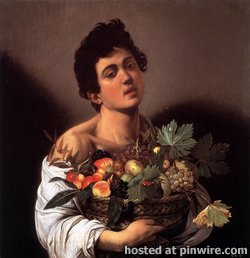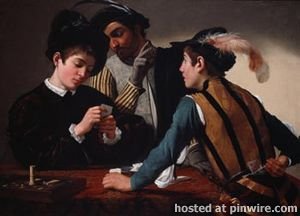Rome (1592-1600)
 Boy with a Basket of Fruit, c. 1593. Oil on canvas, 67 x 53 cm. Galleria Borghese, Rome |
In mid-1592 he arrived in Rome, “naked and extremely needy … without fixed address and without provision … short of money.”[5] A few months later he was doing hack-work for the highly successful Giuseppe Cesari, Pope Clement VIII’s favourite painter, “painting flowers and fruit”[6] in his factory-like workshop.
Known works from this period include a small Boy Peeling a Fruit (his earliest known painting), a Boy with a Basket of Fruit, and the Young Sick Bacchus, supposedly a self-portrait done during convalescence from a serious illness that ended his employment with Cesari. All three demonstrate the physical particularity — one aspect of his realism — for which Caravaggio was to become renowned: the fruit-basket-boy’s produce has been analysed by a professor of horticulture, who was able to identify individual cultivars right down to “… a large fig leaf with a prominent fungal scorch lesion resembling anthracnose (Glomerella cingulata).”.[7]
 The Cardsharps, c. 1594. Oil on canvas, 107 x 99 cm. Kimbell Art Museum, Fort Worth, Texas |
Caravaggio left Cesari in January 1594, determined to make his own way. His fortunes were at their lowest ebb, yet it was now that he forged some extremely important friendships, with the painter Prospero Orsi, the architect Onorio Longhi, and the sixteen year old Sicilian artist Mario Minniti. Orsi, established in the profession, introduced him to influential collectors; Longhi, more balefully, introduced him to the world of Roman street-brawls; and Minniti served as a model and, years later, would be instrumental in helping Caravaggio to important commissions in Sicily.[8] The Fortune Teller, his first composition with more than one figure, shows Mario being cheated by a gypsy girl.
The theme was quite new for Rome, and proved immensely influential over the next century and beyond. This, however, was in the future: at the time, Caravaggio sold it for practically nothing. The Cardsharps — showing another unsophisticated boy falling the victim of card cheats — is even more psychologically complex, and perhaps Caravaggio’s first true masterpiece. Like the Fortune Teller it was immensely popular, and over 50 copies survive. More importantly, it attracted the patronage of Cardinal Francesco Maria Del Monte, one of the leading connoisseurs in Rome.
For Del Monte and his wealthy art-loving circle Caravaggio executed a number of intimate chamber-pieces — The Musicians, The Lute Player, a tipsy Bacchus, an allegorical but realistic Boy Bitten by a Lizard — featuring Minniti and other boy models. The allegedly homoerotic ambience of these paintings has been the centre of considerable dispute amongst scholars and biographers since it was first raised in the later half of the 20th century.[9]



